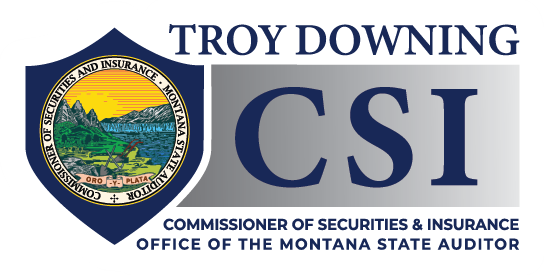
RATES & FORMS
An insurance form—or policy—specifies what a policy will and will not cover. By state law, the CSI is tasked with reviewing forms filed by licensed insurance companies in Montana.
State law also tasks the CSI with reviewing—and, in some cases, approving—the rates of insurance policies sold in Montana.
Below you will find the documents used by insurance companies to submit company rates and forms for review.
We offer the public several methods of accessing insurance company filings electronically.
Insurance company filings are available online at the SERFF Filing Access (“SFA”) website at no charge:
Online Public SERFF Filing AccessFilings can also be viewed at our office located at 840 Helena Ave., Helena, MT during normal business hours.
If you do not locate the information that you are looking for, you may submit a public records request. Fill out the form located HERE. There may be a cost associated with production of a public record.
- Long-Term Care Combination Product New Filing Checklist
- Long-Term Care Combination Product Excel File Template
- Long-Term Care Rate Increase Checklist Templates
- Medicare Supplement Checklist
- P & C Rate/Rule Filing Guide
- Rate Rule or Rate Rule Submittal Certification
- Standard Support for Property & Casualty Rate/Rule Filings
- Work Comp LCM Instructions
- Work Comp LCM Form Page 1
- Work Comp LCM Form Page 2
- Other than Work Comp LCM Form Page 1
- Other than Work Comp LCM Page 2
- Credit History Checklist
- Uninsured, Underinsured and Medical Payments Checklist
In an effort to assist you in the filing of your forms, refer to the list below and the corresponding code sites to ensure that your filing complies in these areas. The filing must comply with all applicable federal and state insurance laws and rules in order to be approved.
A complete reference list coming soon.
Fees are not required for rate and form submissions, except for Health Service Corporations.
PLEASE DO NOT INCLUDE FEES WITH ANY RATES AND FORMS SUBMISSIONS, unless you are a Health Service Corporations.
Health Service Corporations fees:
- Filing of a membership contract—$25
- Filing of a membership contact package—$100
Insurance companies are required to file all of the policy forms, as well as some types of rates and rating plans used in Montana.
Life & Health Filing Procedures
Life and Disability Insurance Rates
Filing of rates is required for Medicare supplement insurance, long term care, individual health, small employer group health, credit life insurance and credit disability insurance. All life and disability insurance premium rates must be reasonable in relation to the benefits provided, and must not be excessive, inadequate or unfairly discriminatory.
Life and disability insurance rate filings must be accompanied by an actuarial memorandum, which describes the rating process. The information required in the actuarial memorandum varies by product. Actuarial memorandums need to be included in the rate filings and not in the form filings.
The actuarial memorandum for Medicare supplement rate filings must include a loss ratio history and a loss ratio projection as required by 6.6.508 ARM (Administrative Rules of Montana), both on a national basis and on a Montana-only basis. Each loss ratio exhibit must show the actual or projected earned premiums and incurred claims and the number of insureds covered under the plan for each year for which the data is available. Including the trend assumption used in the rating and a history of past rate increases, both nationally and in Montana only, will aid the actuary in the analysis.
The actuarial memorandum for credit life and credit disability rate filings must show that the rates comply with the requirements of 6.6.1101 through 1110 ARM. Rates which are not higher than the prima facie rates published in 6.6.1101 and 1103 ARM and which are converted to another basis through the formulas in those sections are eligible for approval as long as the experience meets the loss ratio requirements of 6.6.1110 ARM. Any request for a rate deviation will require an actuarial justification showing why the increase is deemed to be necessary.
Property & Casualty Rate/Rating Plan Filings
All property and casualty rates and rating plans intended for use in the state are required by law to be filed by insurance companies with supporting data to substantiate the filing. The supporting data required varies by the type of filing. The supporting data needs to show that the rate/rating plan is not inadequate, excessive or unfairly discriminatory.
With the exception of certain kinds of workers compensation filings, all property and casual rates and rating plans are subject to “file and use” laws. Workers compensation rate filings that adopt the designated advisory organization loss costs with or without modification, which are at or above the designated advisory organization loss costs are subject to the “file and use” laws. All other workers compensation rates and rating plans must be filed 30 days before the effective date and are subject to prior approval. Crop-hail rate filings must be filed yearly and must be received by the office on or before March 15. With the exception of certain workers compensation filings, property and casualty rates may be used once filed with supporting data.
The general processing procedure of a rate or rating plan filing is similar in most respects to the process for form filings with a few exceptions. All property and casualty filings are reviewed for compliance with the law and administrative rules on a first in/first out basis with the exception of workers compensation filings.
